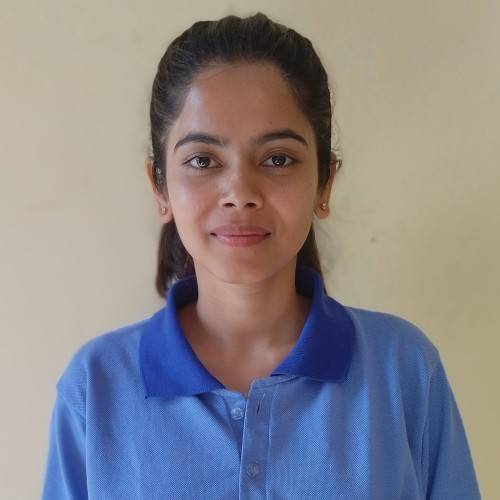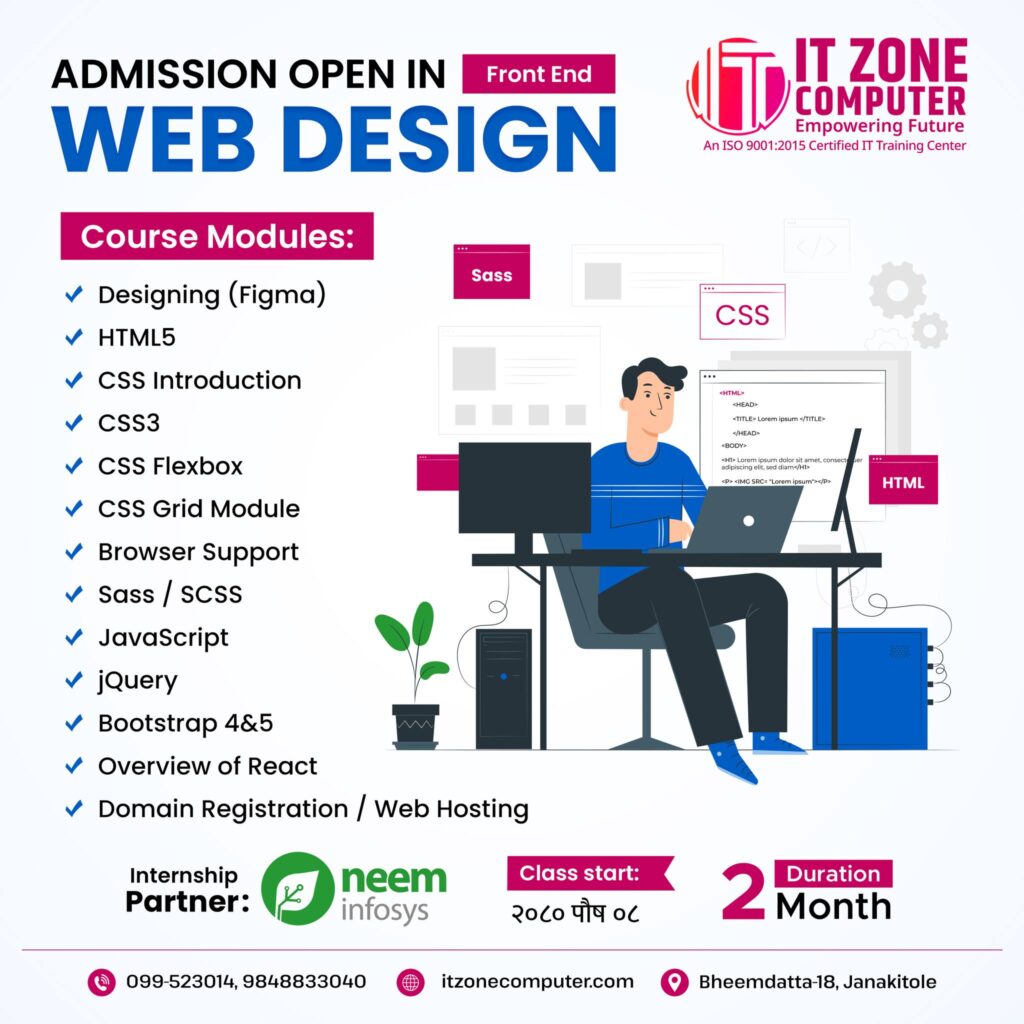About This Course
PHP is a server-side scripting language designed for web development but also used as a general-purpose programming language. There are many things to learn to be an expert PHP Programmer and after completion of this course, students will be able to develop web applications using PHP/MySQL into different levels such as Basic PHP, Object Oriented PHP, and PHP Framework. This course is designed as per the current need for the web development market. This course (PHP Training in MNR, Nepal) is also very useful to those students who are from non- IT background also.
Benefits of Laravel
PHP training in Mahendranagar provides you a new learning scope on PHP, a preferred scripting language to get dynamic sites. It’s used for creating custom-made web solutions because it may be embedded with markup language with minimal effort. Further, it’s comparatively simple to code on PHP because it includes easy formats, techniques, and options. PHP has become an awfully well-liked learning course in the Kingdom of Nepal as a lot of developers are rising within the National IT market. There are varied PHP training suppliers in Nepal within recent times; but, learning PHP from qualified and sensible instructors continuously could be a dream for the aspiring PHP developers
Career Options Laravel
Pre-requisites for Laravel
Before joining the PHP development course, the student should have prior knowledge of Basic Web technologies. It will help them in understanding the PHP training program adequately.
Curriculum
| Lecture |
Unit |
| Lecture 1. 1 |
Installing and setting up Laravel and supporting tools |
| Lecture 1. 2 |
Introduction to Laravel |
| Lecture 1. 3 |
Concept of Composer |
| Lecture 1. 4 |
Install & Use of Composer |
| Lecture 1. 5 |
Installing Laravel using composer |
| Lecture 1. 6 |
Install & Use of open source distributed version control system GIT |
| Lecture 1. 7 |
Concept & Use of GitHub for hosting GIT repositories |
| Lecture 1. 8 |
Configuring Laravel |
| Lecture 1. 9 |
Project Structure |
| Lecture 1.10 |
Setting up Development and Debugging Tools |
| Lecture |
Unit |
| Lecture 2. 1 |
Request Life cycle |
| Lecture 2. 2 |
Gives knowledge of how Laravel actually works. |
| Lecture 2. 3 |
Facade |
| Lecture 2. 4 |
Provides an easy way of accessing application class and libraries |
| Lecture 2. 5 |
Service Providers in Laravel |
| Lecture 2. 6 |
Service providers are the central place of all Laravel application bootstrapping. |
| Lecture |
Unit |
| Lecture 3. 1 |
Basic Routing |
| Lecture 3. 2 |
Named Routing |
| Lecture 3. 3 |
Grouped Routing |
| Lecture 3. 4 |
Routing Parameters |
| Lecture 3. 5 |
Handling Invalid Routes |
| Lecture 3. 6 |
Http Middleware |
| Lecture 3. 7 |
Restful Routing |
| Lecture |
Unit |
| Lecture 4. 1 |
Introduction |
| Lecture 4. 2 |
Basic Controllers |
| Lecture 4. 3 |
Restful Resource Controllers |
| Lecture 4. 4 |
Controller Routing |
| Lecture 4. 5 |
Controller Middleware |
| Lecture |
Unit |
| Lecture 5. 1 |
Request |
| Lecture 5. 2 |
Basic Controllers |
| Lecture 5. 3 |
Handling Request Info. |
| Lecture 5. 4 |
Request Inputs |
| Lecture 5. 5 |
Form Inputs |
| Lecture 5. 6 |
Files |
| Lecture |
Unit |
| Lecture 6. 1 |
Attach Headers and Cookie to response |
| Lecture 6. 2 |
Response with View |
| Lecture 6. 3 |
Restful Resource Controllers |
| Lecture 6. 4 |
Response with JSON |
| Lecture 6. 5 |
Response with File |
| Lecture |
Unit |
| Lecture 7. 1 |
Introduction |
| Lecture 7. 2 |
Migration |
| Lecture 7. 3 |
Schema Building |
| Lecture 7. 4 |
Migration Structure |
| Lecture 7. 5 |
Running Migration |
| Lecture 7. 6 |
Writing Migration |
| Lecture 7. 7 |
Running Migration |
| Lecture 7. 8 |
Database Configuration |
| Lecture 7. 9 |
Running Raw SQL queries |
| Lecture |
Unit |
| Lecture 8. 1 |
Eloquent ORM |
| Lecture 8. 2 |
Defining Model |
| Lecture 8. 3 |
Retrieving Model |
| Lecture 8. 4 |
Insert & Update Model |
| Lecture 8. 5 |
Deleting Model |
| Lecture 8. 6 |
Eloquent Relationship |
| Lecture 8. 7 |
One to One |
| Lecture 8. 8 |
Many to Many |
| Lecture |
Unit |
| Lecture 9. 1 |
Passing data to view |
| Lecture 9. 2 |
Sharing data to all views |
| Lecture 9. 3 |
Blade Template Engine |
| Lecture 9. 4 |
Introduction |
| Lecture 9. 5 |
Template Inheritance |
| Lecture 9. 6 |
Displaying Data |
| Lecture 9. 7 |
Implement Control Structures |
| Lecture |
Unit |
| Lecture 10. 1 |
Installation |
| Lecture 10. 2 |
Generating form |
| Lecture 10. 3 |
CSRF Protection |
| Lecture 10. 4 |
Form Elements |
| Lecture 10. 5 |
Labels |
| Lecture 10. 6 |
Text, Text Area, Password & Hidden Fields |
| Lecture 10. 7 |
File Input |
| Lecture 10. 8 |
Number Input |
| Lecture 10. 9 |
Date Input |
| Lecture 10. 10 |
Buttons |
| Lecture 10. 11 |
Custom Form Macros |
| Lecture |
Unit |
| Lecture 11. 1 |
Authentication our application |
| Lecture 11. 2 |
Authorization using Policies ~ Role based panel access |
| Lecture 11. 3 |
Introduction |
| Lecture 11. 4 |
Configuring Auth Library |
| Lecture 11. 5 |
Creating authentication system using Middleware |
| Lecture 11. 6 |
Artisan Console |
| Lecture 11. 7 |
Exception Handling and Error Logging |
| Lecture 11. 8 |
Mail |
| Lecture 11. 9 |
Configuring & sending mail |
| Lecture 11. 10 |
Pagination |
| Lecture 11. 11 |
Session |
| Lecture 11. 12 |
Validation |
| Lecture 11. 13 |
Validation Rules with associating messages |
| Lecture 11. 14 |
Custom Rules with associating custom messages |
| Lecture 11. 15 |
Laravel Socialite ~ Registrtion & Login with 3rd party ( FB, Google, Github etc ) |
| Lecture 11. 16 |
WebPack ~ Building assets |
| Lecture 11. 17 |
Laravel mix |
| Lecture |
Unit |
| Lecture 12. 1 |
Concept of API, why and scope of implementation |
| Lecture 12. 2 |
Restful API setup, Basic project |
| Lecture 12. 3 |
Tools ~ Postman Tool |
| Lecture 12. 4 |
Project Work: |
| Lecture 12. 5 |
E-commerce Website with Multi-vendor concept. |
Instructor









Average Rating
4.5
508 ratings
Detailed Rating